The more I learn about ducks, the more impressed I am with their blatant promiscuity. Mallards, of course, bring new meaning to the term dabbling duck, what with all those wild mallard hybrids and domestic cross-breeds running around. But apparently, all the Anas-species ducks are overly amorous or at least indiscriminate. Consider the teals. Teal is a broad term for a variety of dabbling ducks in the genus Anas. One will find teals all over the world, but we generally see three different species in North America: Blue-winged, Green-winged, and Cinnamon:
Those beauties represent baseline for American teals, which is why these two birds raised eyebrows:
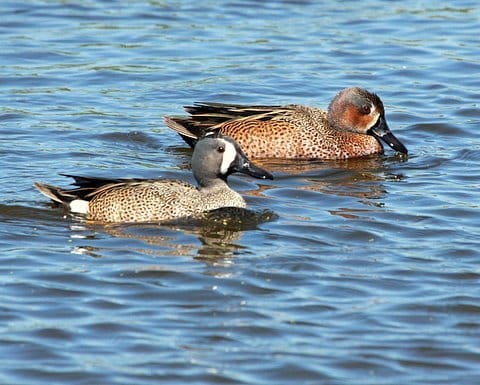
Now, one of these ducks is clearly a male Blue-winged Teal, but its buddy looks a bit off, wouldn’t you say? Are you willing to hazard a guess about its lineage?
My friend Eva at The Flying Mullet had her ideas, but sent some photos to me (more here) for further feedback. Actually, she didn’t necessarily want to tap my ID skills, such as they are, but the aggregated ornithological genius of the 10,000 Birds readership. Still, I had my guess, as I suspect you might too. Here’s another look…
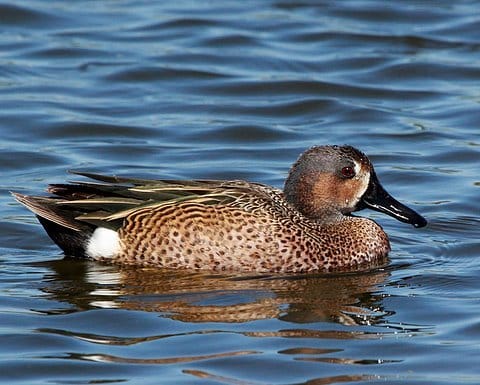
This odd duck appears to be Blue-winged x Cinnamon Teal. Certain aspects of this identification are problematic, such as the bird’s shape, location, and limited cinnamon rustiness on its body or breast. However, Blue-winged x Cinnamon crosses have been spotted before by, for example, Bill Schmoker, Greg Lasley, and still others.
NORTH AMERICAN TEAL HYBRIDS
Clearly at least two teal species take to each other. What about the rest? Researching this single hybrid revealed that teals are as liberal with their love as mallards! Realizing how extensive the dalliances of these ducks really were, I turned to an expert. Jörn Lehmhus has studied hybrid ducks more extensively than anyone I know; his Flickr set on hybrids may be the most extensive resource on the topic online anywhere!
Hybrid ducks can be a pain to identify, as they are not just intermediate between parent species, but can show patterns resembling a third species or even some patterns and colorations existing in no true duck species anywhere in the world. Therefore when Mike addressed me with a request concerning hybrid teals, I thought it a good idea to address some misidentifications in the web.
Jörn has provided outstanding examples of other North American teal hybrids:
Blue-winged x Cinnamon Teal makes for a very variable hybrid. This captive individual photographed by Liz Barrett has a greyish head patch starting around the eye, which may in shape slightly resemble the green head patch of Green-winged Teal.
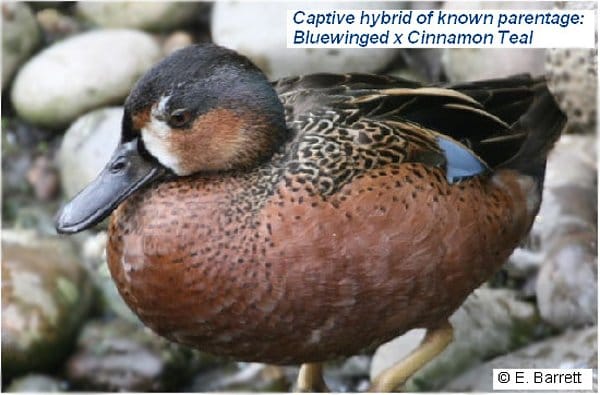
Blue-winged x Cinnamon Teal © Liz Barrett
Together with the rusty red ground coloration of the head, this might make you think of Green-winged Teal parentage for a moment. But the coloration of the patch is typical Blue-winged Teal: blue-grey without any green iridescence. Also note the white crescent in the face, which isn’t shown by all hybrids of this type, and the Cinnamon Teal body coloration (Flanks may be more patterned in other hybrids of this type though, and could be a bit paler.)
The Blue-winged x Green-winged Teal hybrid can be quite handsome, as this captive hybrid of known parentage photographed by Mark Hall shows:
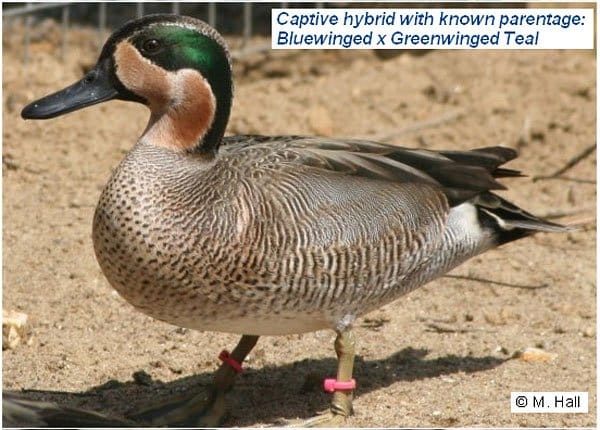
Blue-winged x Green-winged Teal © Mark Hall
This duck’s head pattern is typical with a slight resemblance to Baikal Teal or hybrid Green-winged x Cinnamon Teal due to the green iridescence in the dark patch over the eye. The flanks are partly striped but also finely vermiculated in part.
An exquisite example of the Blue-winged x Green-winged Teal hybrid in the wild was photographed at Brazos Bend State Park in Texas in February 2012:
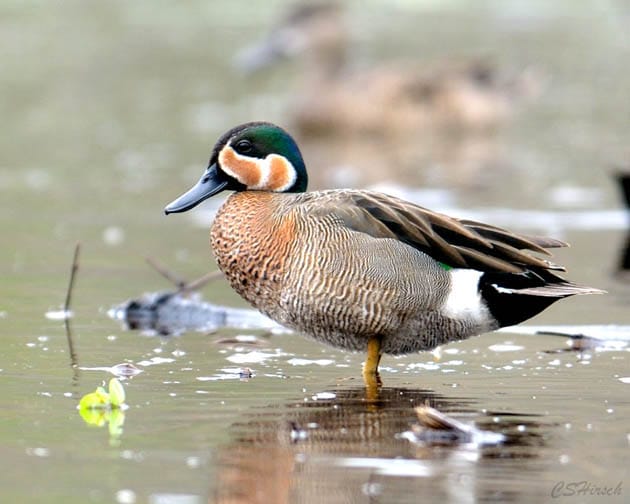
Blue-winged x Green-winged Teal © Chris Hirsch
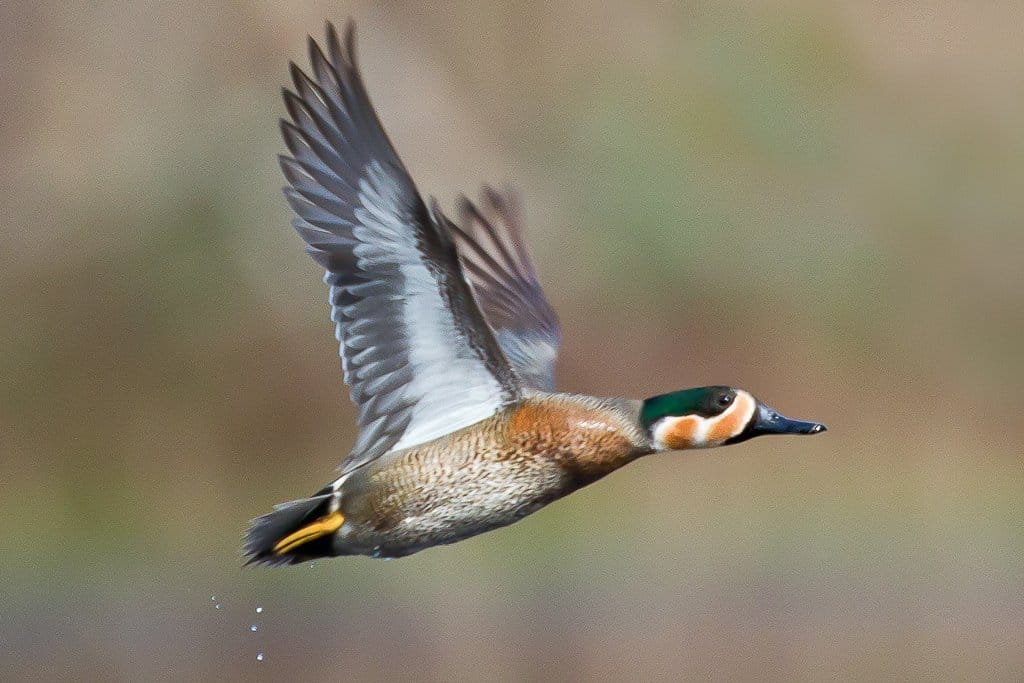 Blue-winged x Green-winged Teal © Tom Ellis
Blue-winged x Green-winged Teal © Tom Ellis
Cinnamon Teal x Common or Green-winged Teal hybrids can be among the rarest of North American teal hybrids in Joern’s experience:
I have seen pictures of only 2 such birds and a 3rd bird (the one mentioned above) in life. Blue-winged x Green-winged or Common Teal hybrids seem to be slightly more common (I have seen pictures of 12 different birds of this combination) and Blue-winged x Cinnamon Teal very common in comparison (I know pictures of at least 75 different hybrids of this combination.)
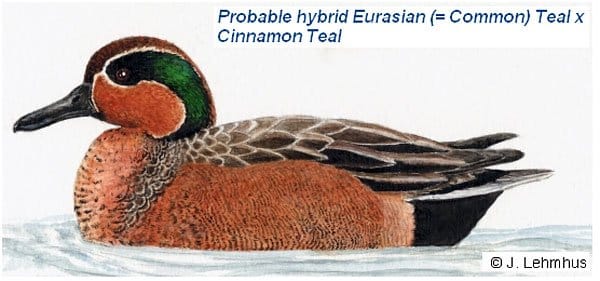
Cinnamon Teal x Common or Green-winged Teal © Jörn Lehmhus
HOW ABOUT THOSE GREEN-WINGED TEALS?
As these specimens suggest, Green-winged Teals get around. However, they present a special challenge to those of us who marvel at the flexible fecundity of ducks. To wit, when is a hybrid possibly not a hybrid? The Green-winged Teal is divided into two recognized subspecies. The American Green-winged Teal (Anas crecca carolinensis), found just about anywhere in North America, and the Eurasian Green-winged Teal (Anas crecca crecca), also known as the Common Teal but only common in the Old World. Some authorities recognize these races as distinct species, but that doesn’t doesn’t deter these ducks from the odd dalliances:
Eurasian x Green-winged Teal hybrid © Dave Appleton www.gobirding.eu
(See Dave’s amazing Hybrid Ducks page for this and many other creative combinations!)
David Sibley offers an excellent tutorial on separating these two teals, including original renderings of variant intergrade or hybrid Eurasian x American Green-winged Teals.
TEALS AND OTHER DUCKS
The term “teal” actually gets bandied about a bit too freely across the entire Anas genus, which places many different teals in what will probably one day be separate genera. Thus, we shouldn’t be surprised when we find teals hybridizing with other Anas ducks. For example, the likelihood of teals hybridizing with Mallards makes perfect sense, given the latter’s fearsome fecundity. Photographer C G Gustavsson captured shots of what appears to be a Eurasian Teal x Mallard in Copenhagen, Denmark, which he’s graciously shared with us here:
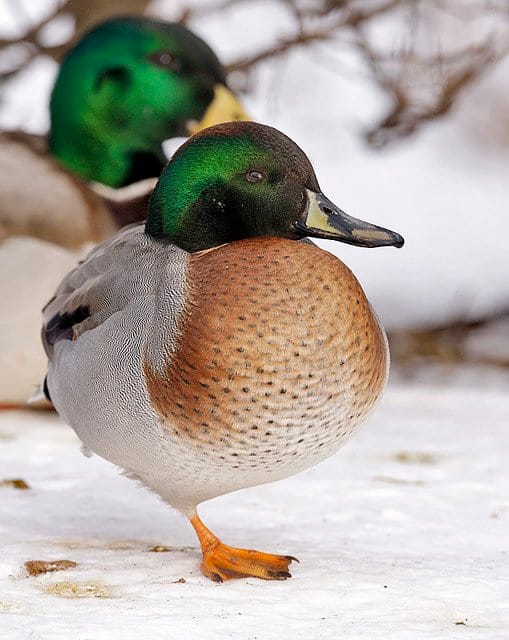
Eurasian Teal x Mallard © C G Gustavsson
(See all of C G Gustavsson’s amazing hybrid ducks and geese in his Flickr photostream)
Yes, teals cross with mallards, with wigeons, and most prominently with shovelers. Teal x Northern Shoveler hybrids seem fairly regular in North America and Europe. That prominent bill makes at least part of the parentage obvious in these hybrids and head pattern is also very similar, but more confusing can be the identity of the teal parent. Fortunately, Jörn Lehmhus (to whom I’m enormously grateful for his expertise and generosity) is on the case:
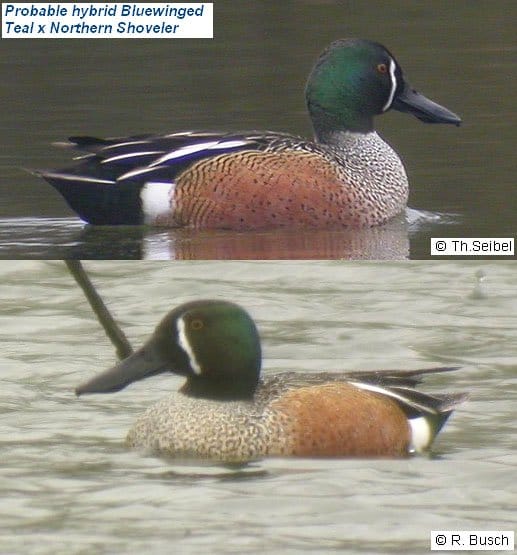
Blue-winged Teal x Northern Shoveler © Thorsten Seibel and Ralf Busch
Blue-winged Teal x Northern Shoveler hybrids can be identified by the following features:
- White breast with fine black pattern
- Reddish-brown flanks in general paler than in shoveler and with some black markings
- Black head with green iridescence and white crescent
- Yellow to dark yellow-brown iris
- White patch on rear flanks
In fact, this pattern and coloration strongly resembles that of the southern hemisphere species Australasian Shoveler (including New Zealand Shoveler), but the hybrid also shows important differences like the distinct green iridescence of the head, lighter flanks, and finer patterning on breast and flanks.
The Blue-winged Teal x Northern Shoveler is also rather similar to the Cinnamon Teal x Northern Shoveler, which can easily lead to misidentification.
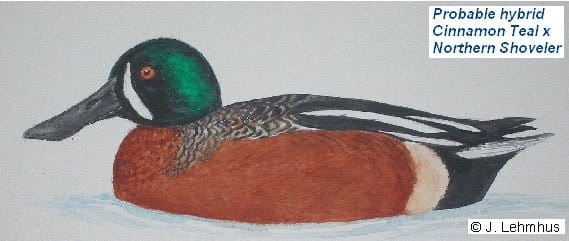
A drawing of a hybrid Cinnamon Teal x Northern Shoveler by Jörn Lehmhus
The head pattern of the Cinnamon Teal x Northern Shoveler hybrid is very similar to the previous hybrid. Also there may occur some dark spotting on the rust red breast and in some cases rather faint barring on the rear flanks. So how do we know this bird isn’t just another variant Blue-winged Teal x Northern Shoveler hybrid?
On the one hand, a description exists of a captive hybrid of known parentage (male Cinnamon Teal x female Northern Shoveler), which had a similar head pattern and body coloration. In contrast to Blue-winged Teal x Northern Shoveler hybrids, the iris colour in Cinnamon Teal x Northern Shoveler is either clear yellow, orange, or red. The breast and flanks are a darker rusty red, darker and the pale patch on the rear flanks can be white but often has a slight rusty colour tinge.
ALL THE OTHER TEALS…
You can find small dabbling ducks called teals all over the world. These teals can also hybridize, but for the sake of both brevity and sanity we’ll stop with the aforementioned North American hybrids. A general rule when looking at a hybrid teal is that the variability of hybrids often is much broader than that of either parent species. Even so, hybrids not identifiable after comparison with the images presented here might involve one (or two) of these other teals. Aren’t hybrid ducks fun?
*** Have you seen any hybrid teals lately? ***
If you have great photos of hybrid teals you’d like us to add to this gallery, send them to mike AT 10000birds DOT com!



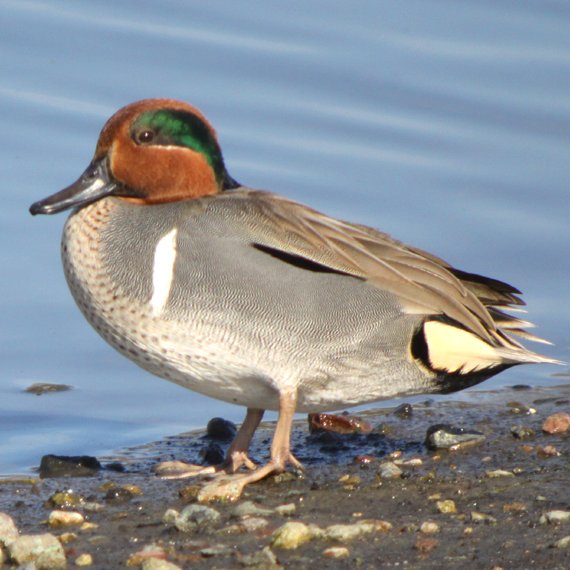
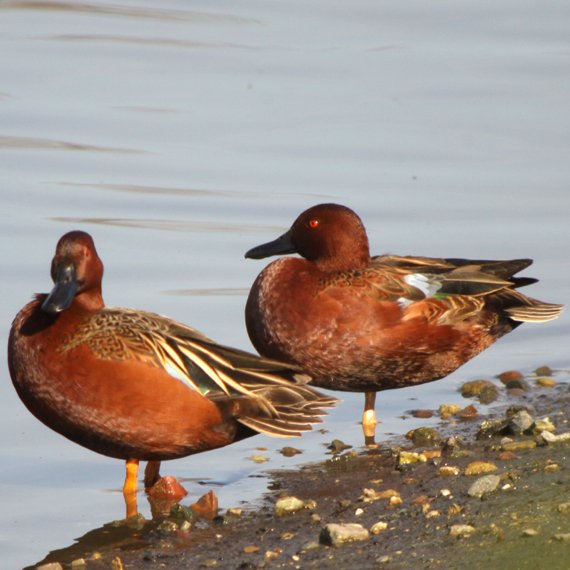
%20L.JPG)











At Bristol they have two Ruddy x Common shelduck hybrids – I will try to get a picture on my blog. The different birds are not very similar to each other or their parents
Bitchin’ post, Mike! As a blogger I can appreciate what went into it. Those hybrid teal are sharp-looking birds–I think my favorite is the shoveler x blue-winged teal. Neat, neat bird. Thank you for laying this out so clearly and beautifully. A labor of love, much appreciated.
@Alan, I’d love to see those photos.
@Julie, thanks! This was definitely a lot of fun to put together, but I admit to becoming a bit intimidated once I realized the scope of the project. Luckily, Jörn Lehmhus generously shared his expertise in this sordid and specialized area, as did many others!
Mike
Over on Project Noah, we are debating about a duck that may be some kind of Mallard x ? Teal Hybrid.
http://www.projectnoah.org/spottings/6803042
Hope you can see this..
Hi Mike and others,
The hybrid on the Project Noah website is a typical mallard x muscovy duck. These come in a lot of different colours due to the many domestic races of both these birds. But in general wild coloured hybrids of that combination have the green speculum. See some of the variability of this cross here:
http://www.flickr.com/groups/hybridbirds/discuss/72157602472617276/
the Cinnamon Teal x Shoveler hybrid from above is confirmed as I had the chance to see a photo of the captive bred hybrid shoveler x cinnamon teal from the Natural History Museum at Tring , England. That bird with known parentage matches the wild ones exactly.
Jörn
Jörn, you continue to amaze me. I knew the bird wasn’t a mallard x teal, but thought it looked superficially like a teal x teal cross. Glad you came to the rescue!
Hi Mike,
I spotted this odd teal in Galveston on Nov 6th, 2011. It appears to be a Blue-winged x Green-winged cross.
http://www.pbase.com/davidmcd/image/139446152
I would appreciate your take on this birds parentage. Thanks
Wow, David, I can’t figure out what that bird is. Mind if I post the photo for more potential input?
David, I’d say there is Gadwall parentage in that bird. Maybe GW x Gadwall?
very kewl stuff
i also have a pic of a strange green wing
http://s1238.photobucket.com/albums/ff500/rporter314/nov%201/?action=view¤t=_MG_2392A.jpg
maybe this one is easy and not a hybrid
Hi there,
Both these birds
http://s1238.photobucket.com/albums/ff500/rporter314/nov%201/?action=view¤t=_MG_2392A.jpg
and
http://www.pbase.com/davidmcd/image/139446152
are actually no hybrids in my opinion, but just Greenwinged Teal in plumage change in between eclipse plumage and breeding plumage.
Ducks can look very odd during this time.
Jörn
thanks Jörn … Crossley has a pic which is identical to David’s bird
i am convinced now that my pic is also a bird in eclipse
thanks for your response
Just found about your blog on hybrids, especially Teal and I photographed this duck this morning in Arizona. It was in a huge flock of Cinnamon Teal and also quite a few Green-wing Teal. Also had a few Shovelers not far away. Any idea if this might be a hybrid, or maybe nothing at all. My first thought in the field was Cin X BW, but this one does not look like the other examples, so maybe something else. I also photographed a possible luecistic Cinnamon Teal in the same flock.
Thanks in advance for any insight!
http://www.flickr.com/photos/52522884@N03/6863418954/in/photostream
I am having a heck of a time id’ing a group of ducks at my neighborhood pond. The pictures on this site are the closest I can get to them. I have never seen anything like them before. They look a lot like Shovelers with the unmistakeable bills, have greyish heads, set low in the water,have blue bands on their wings, but the frustrating thing is that they DIVE!!! There are Shovelers, Widgeons, and Green Wing Teals present and they all showed up at about the same time. But none of these are divers. They are all dabblers. Any clues? I have not been successful at getting good pictures, but will keep trying.
Apparently there’s a Cinnamon x Green-winged Teal in Gilbert, AZ – see
http://www.flickr.com/photos/azorange/11439648303/in/set-72157629065818888/
It does not look like others that I can find of this combination, though, and takes more after the GWTE side.
I’d love your opinion on this mostly-mallard, from Alameda County California:
https://photos.app.goo.gl/WpAwJ1XCCUdAuEaH9
her head and beak put me in mind of blue-winged teal